Did you know that coffee cupping is centuries old, originating in the coffee houses of the Ottoman Empire? Today, this technique has become a pillar in the world of coffee connoisseurs and professionals alike, utilized as a systematic process to test and compare the quality, flavors, and aromas of different coffee beans.

This comprehensive guide is crafted as a how-to resource for coffee enthusiasts looking to elevate their coffee-tasting skills. It's designed to empower you to conduct your own coffee cupping sessions and develop a more nuanced palate. Let's delve deeper into this art and learn how to maximize your coffee-tasting experience.
Coffee Cupping: A Detailed Overview
Coffee cupping, also called 'cupping,' evaluates different aspects of the coffee's taste and aroma. In many ways, it's akin to wine tasting. It's an established practice in the coffee industry, employed by professionals like coffee buyers, roasters, and baristas to assess the quality of the coffee bean and identify its distinct flavor notes.
But what exactly does the cupping process involve? Let's delve into the specifics.
Setting the Stage
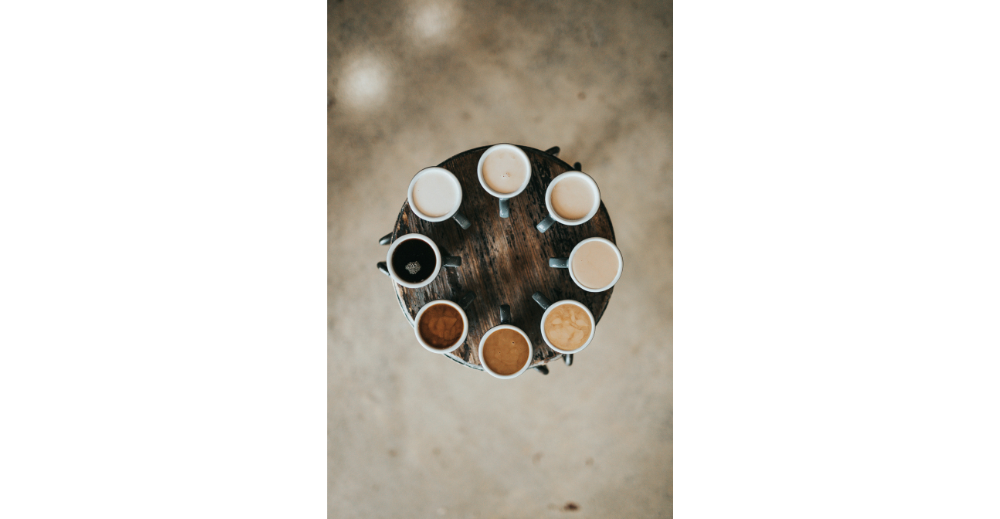
The first step in coffee cupping involves setting up the cupping table. This involves arranging many cupping bowls (or cups) in a line or circle, with each cup containing a sample of a different coffee. Additionally, cups of water and cupping spoons - resembling a soup spoon - are placed on the table.
Examining the Beans and Grinds
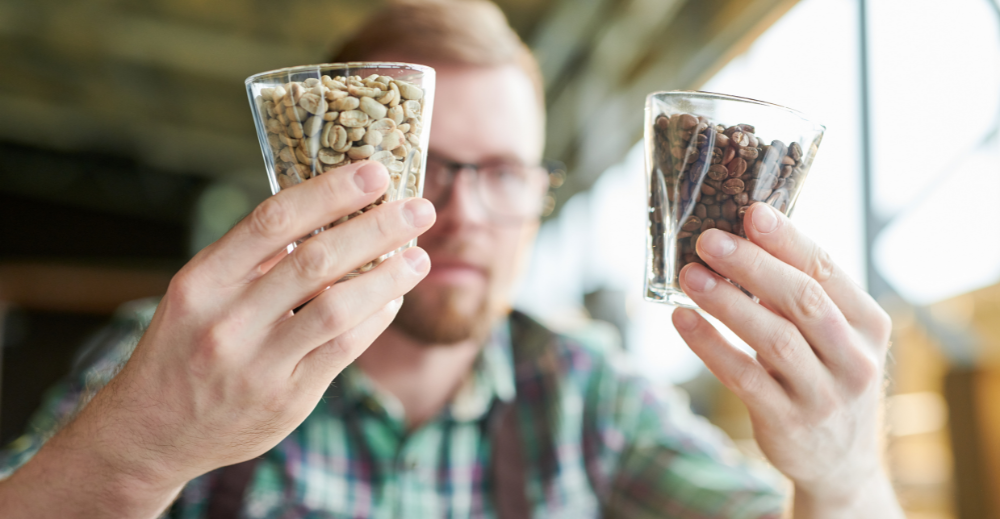
The process starts with examining the beans and grounds. The beans' size, shape, and color can give clues about their origin and roast level. The roasted coffee grounds are then sniffed for a first pass at their aroma.
Brewing
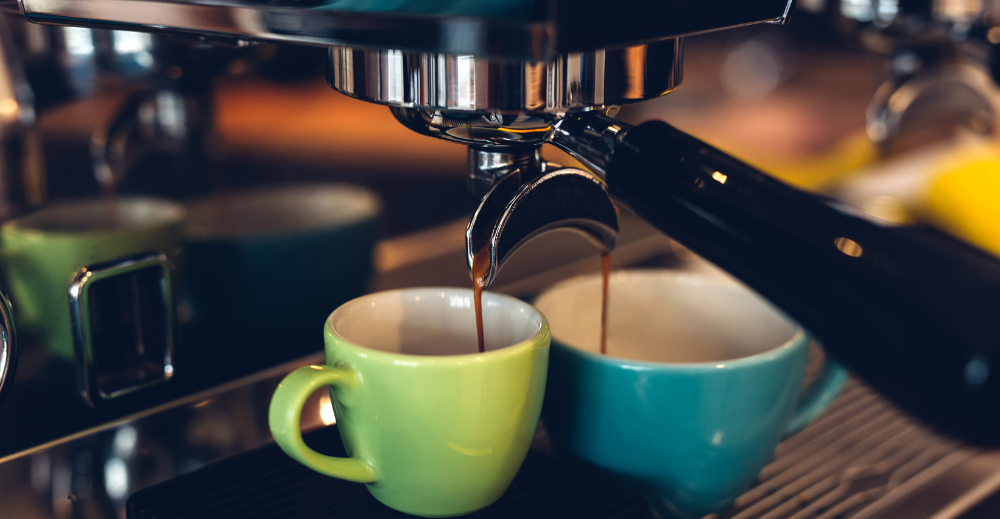
Hot water is poured over the coffee grounds in each cup. The coffee is left to steep for a few minutes, forming a 'crust' at the top of the cup. This period also allows for evaluating the coffee's aroma, as the heat releases the volatile compounds in the coffee.
Breaking the Crust
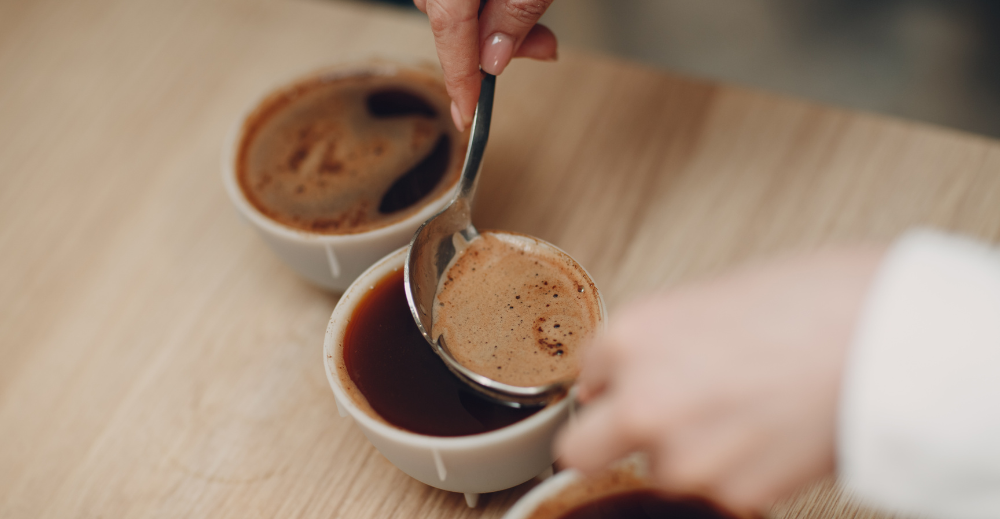
The crust is 'broken' with a spoon after the steeping period. This action releases a burst of aromas, allowing for another round of evaluation. The spoon is also used to skim off any remaining ground coffee from the surface of the cup.
Tasting
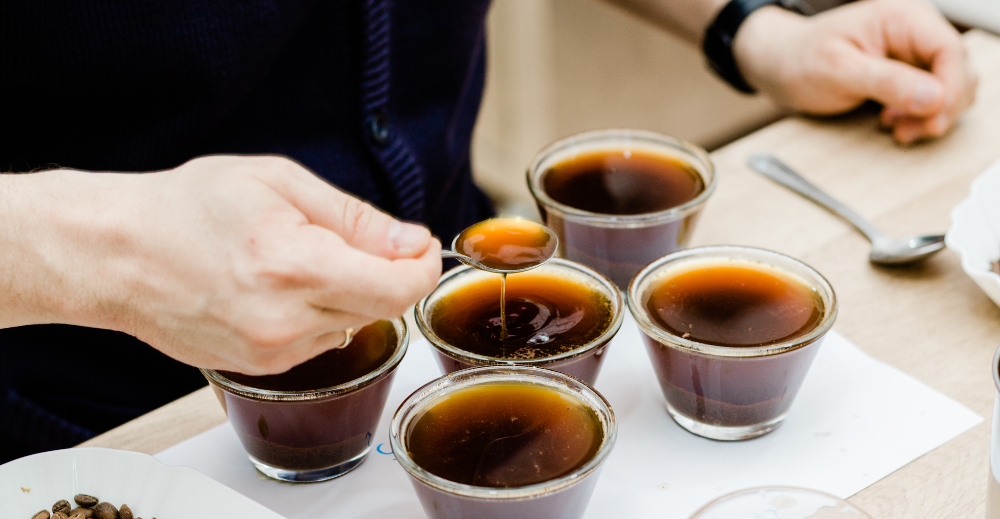
After the coffee cools, it's time for tasting. A small amount of coffee is slurped from the spoon, aspirating it over the entire palate. This process helps to taste coffee and identify sweetness, acidity, flavor, aftertaste, and body - the essential elements that define a coffee's character.
Scoring
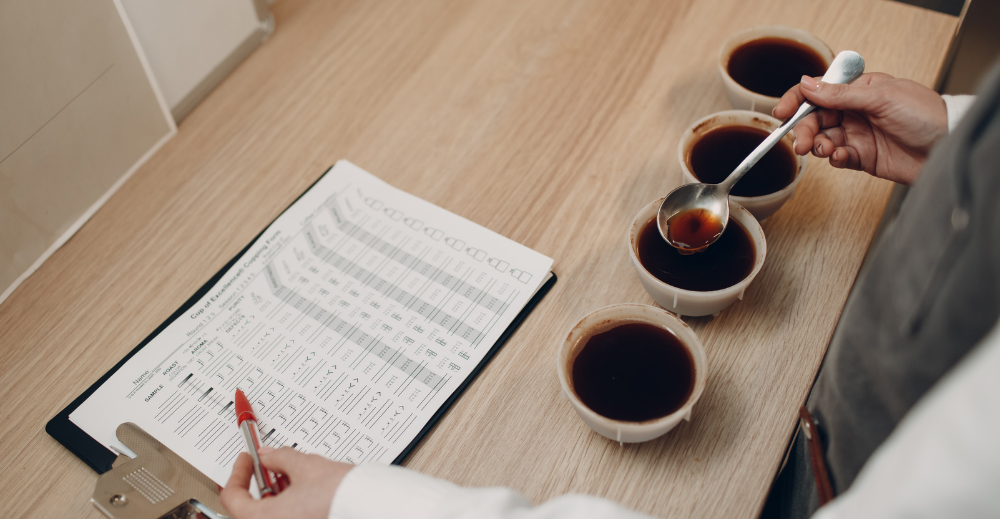
Finally, the coffee is scored based on attributes like aroma, flavor, aftertaste, acidity, body, and balance. Each coffee can receive a score between 6 (for a not-good coffee) and 9.5 (for an extraordinary coffee).
The First Steps: Cupping Coffee and Cultivating Your Palate
Cupping is a sensory journey that enables you to appreciate the full depth of flavors in coffee. Following a systematic process can develop your taste buds to distinguish between the multitude of flavors present in coffee.
Here's a detailed guide to help you get started:
-
Selecting Coffee Beans: The first step in your cupping journey is the selection of beans. Opt for different types of roasted beans, as each type possesses a unique flavor profile. These could be beans from different geographical locations, beans that have been processed in varied manners, or beans with different roast levels.
-
Grinding the Coffee: With your beans selected, it's time to grind them. The grind size of your coffee grounds plays a crucial role in cupping coffees. Be consistent in your grind size across all the coffee samples, ensuring they are ground.
-
Preparing the Coffee: Place an equal amount of ground coffee into separate cups. The exact amount will depend on the cup size, but consistency is critical. Following this, pour hot filtered water into the cups. The water should be off the boil, allowing the coffee to steep.
-
Observing the Aroma: Before you break the crust, take a moment to inhale the aroma of the dry grounds, then again after adding boiling water. The aroma of coffee can hint at the flavor notes and characteristics.
-
Breaking the Crust: After 4 minutes, the coffee grounds will form a 'crust' at the top. Break this crust with a cupping spoon, and inhale the rush of aroma. This practice will give you a first hint of the coffee's characteristics. Any floating grounds should be removed and discarded.
-
Tasting the Coffee: Finally, the stage you've been waiting for - tasting. Use two spoons to gather a small amount of coffee, slurping it to aerate and spread it over your palate. This will allow you to note the coffee's sweetness, acidity, and flavor notes. Always rinse your spoon in heated water between tastings to prevent cross-contamination.
-
Noting Impressions: Throughout the process, maintain a cupping form or a journal to note your observations. This is a crucial step in improving your palate, as you can refer to your notes in future cupping sessions. Write your thoughts on the aroma, flavor, aftertaste, acidity, body, and balance.
Remember, cultivating a refined palate takes time and practice. It's fine if you cannot identify specific flavors. Over time and with more cupping sessions, you'll distinguish between different flavors and understand what each cup of coffee offers.
Why Cupping is Vital in the Coffee Industry

In the coffee industry, cupping isn't a process; it's a vital tool for quality control and product development. It provides a common language and standards, enabling professionals worldwide to test coffee.
Quality Assurance
Cupping is integral to the coffee industry's quality and assurance process. Coffee experts use cupping to test the quality and consistency of coffee samples. It helps them identify any defects or off-flavors in the coffee, ensuring that only the highest quality beans reach the consumers.
Identifying Flavor Profiles
Coffee cupping allows professionals to identify and describe the unique flavor profiles of different coffees. This can be especially beneficial for roasters and coffee buyers who need to understand the characteristics of the beans they're sourcing.
Product Development
Cupping is indispensable if a coffee roaster wants to develop a new blend. By understanding the flavors of different beans, roasters can combine beans to bring out desired flavor notes, creating exciting new blends.
Standardization
The Specialty Coffee Association (SCA) has established a set of protocols for cupping. By following these protocols, coffee experts worldwide can ensure that their evaluations are objective and standardized. This level of standardization also aids in maintaining a fair and transparent global coffee market.
Education and Training
Cupping is also used as a critical educational tool in the industry. It's a practical way to train new professionals about coffee flavors, aromas, and quality indicators. Additionally, it's an effective method for developing a refined palate, a critical skill in the industry.
The Power of Comparison in Uncovering Coffee Flavors
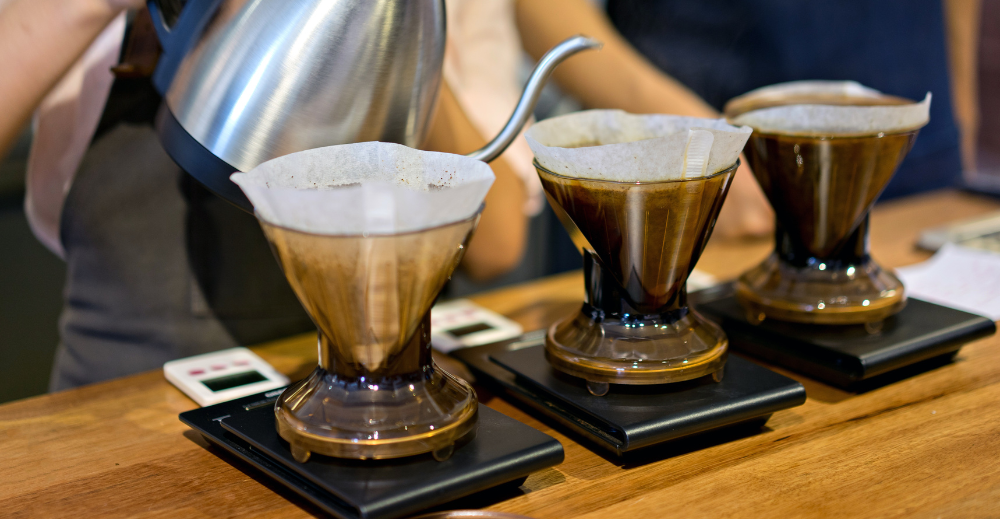
Comparison is vital in unlocking the diversity and depth of coffee's flavors. Comparing different coffees side by side in a cupping session can help you identify the unique characteristics of each coffee and develop a nuanced understanding of coffee flavors.
Here's why and how a comparison is a powerful tool in coffee cupping:
-
Exposure to Diversity
Coffee beans from different regions have distinct flavor profiles due to variations in soil, climate, and cultivation practices. By comparing different coffees during cupping, you expose your palate to this rich diversity, helping you discover a range of flavors you might not have noticed otherwise.
-
Identification of Unique Characteristics
Their differences become more clear when you cup many coffees. For instance, the fruity notes of an Ethiopian coffee might stand out compared to a Colombian coffee with nutty notes. This practice helps you identify and appreciate the unique characteristics of each coffee.
-
Building Flavor Memory
Comparing different coffees helps you build a mental library of flavors. Over time, your palate will remember the specific flavors associated with different types of coffee, enhancing your cupping and tasting skills.
-
Understanding Preference
Comparison helps you understand your personal preference. By tasting different coffees, you might discover that you have a penchant for the bright acidity of Kenyan coffee or the earthy tones of Sumatran coffee.
To reap the benefits of comparison, consider setting up your cupping session with a diverse selection of coffees. Choose beans from different regions with different processing methods or roast levels. Make sure to take detailed tasting notes as you go.
There's no right or wrong about personal preference. The goal is to savor the experience and expand your understanding of the beautiful world of coffee flavors.
Step-by-Step Guide to Your First Coffee Cupping Session
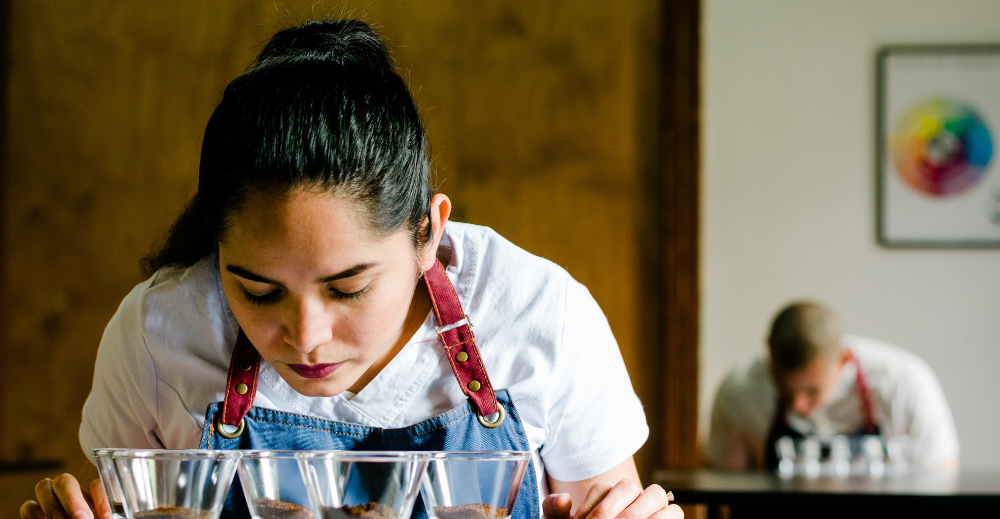
Cupping for the first time can be an enlightening and exciting experience. Here's a step-by-step guide to help you conduct your first cupping session:
-
Preparation: Gather your coffee samples, ensuring they are roasted and ground. Also, gather your cupping equipment: cupping bowls, spoons, hot filtered water, and a grinder if you're grinding your own coffee.
-
Measure: Consistency is key in cupping. Measure the same amount of ground coffee into each cupping bowl. The SCA suggests a ratio of 8.25 grams of coffee per 150 ml of water.
-
Smell the Dry Grounds: Lean over each bowl and inhale. This is your first impression of the aroma. Write down your observations on your cupping form.
-
Add Hot Water: Pour hot water (just off the boil) into each bowl, ensuring all the grounds are saturated. Allow the coffee to steep for 4 minutes.
-
Break the Crust: After 4 minutes, a crust of ground coffee will have formed on the surface. Take your cupping spoon and break this crust, stirring three times. As you do this, lean over the bowl and smell the aroma released.
-
Clean the Surface: Remove the remaining grounds floating on the surface using two spoons to avoid bitterness.
-
Taste the Coffee: Once the coffee cools slightly, start tasting. Dip your spoon into the bowl, then slurp the coffee. The goal is to aerate the coffee, allowing it to cover your entire palate. Taste each coffee sample in the same order you smelled them.
-
Evaluate: Note your impressions of each coffee's aroma, flavor, aftertaste, acidity, body, and balance. You can also identify any defects or off-flavors.
-
Compare: Taste and compare the side of the different coffee by the side. Notice any differences or similarities. This step is where the power of comparison shines in discovering unique coffee flavors.
-
Repeat: As the coffee cools, its flavor profile may change. Continue tasting and comparing the coffees as they cool to room temperature.
Advanced Tips to Refine Your Coffee Cupping Skills
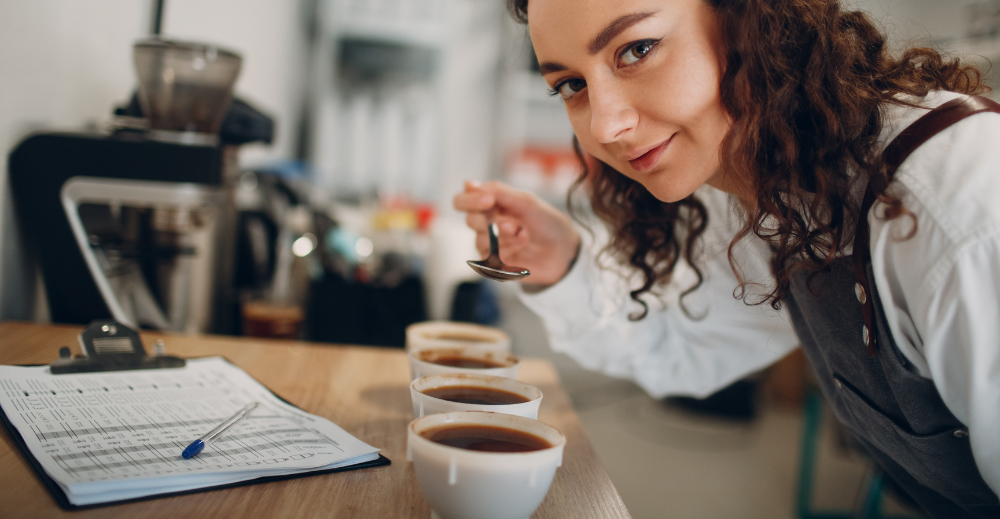
As you venture deeper into the coffee cupping world, you might seek ways to refine your tasting skills and cultivate a more discerning palate.
Tip #1: Experiment with Grind Size
Different grind sizes can influence the extraction of flavors from the coffee. Try experimenting with finer or coarser grinds and observe the impact on the coffee's taste and aroma.
Tip #2: Explore Various Roast Levels
Coffees roasted to different levels can present diverse flavor profiles. Try tasting coffees at various roast levels to appreciate the spectrum of flavors and aromas from light to dark roast.
Tip #3: Taste Blind
Blind tasting, where you don't know the origin or type of the coffee you're cupping, can be a great way to develop unbiased assessments. It encourages you to rely on your taste buds and intuition.
Tip #4: Learn from the Coffee Professional
Attend cupping sessions hosted by the coffee professional or SCA events. This provides an opportunity to learn from experts and exposes you to a wider variety of coffees.
Tip #5: Keep a Tasting Journal
Document your observations and thoughts about each coffee you taste. Over time, this will become a valuable resource for tracking your palate development and coffee experiences.
Tip #6: Involve Your Other Senses
While taste is crucial in coffee cupping, don't neglect your other senses. The appearance, smell, and even sound of the brewing coffee can provide valuable insights into the coffee's quality and characteristics.
Tip #7: Cleanse Your Palate
To maintain the integrity of your tasting experience, cleanse your palate between tasting different coffees. This prevents cross-contamination of flavors and helps keep your taste buds fresh.
Tip #8: Consistency is Key
Regular practice is essential for refining your cupping skills. With time, your ability to discern and appreciate the myriad flavors in coffee will improve.
Embarking on Your Coffee Cupping Journey

Understanding the art of coffee cupping is a valuable step. It empowers you to discern the nuances of different coffees and appreciates the craftsmanship that goes into every cup. So, embark on this coffee-tasting journey and discover a world of flavors awaiting your exploration.
We encourage you to try coffee cupping at home using our guide. It's a fulfilling practice that improves your palate and enhances your understanding and appreciation of coffee. Check out CoffeeRoast Co. if you're looking for high-quality roasting machines or grinders for your cupping sessions.
If you found this helpful guide, don't forget to share it with your fellow coffee lovers!





Shumbusho saidi
febrero 13, 2024
Hello
I’m shumbusho saidi from Rwanda I’m barista